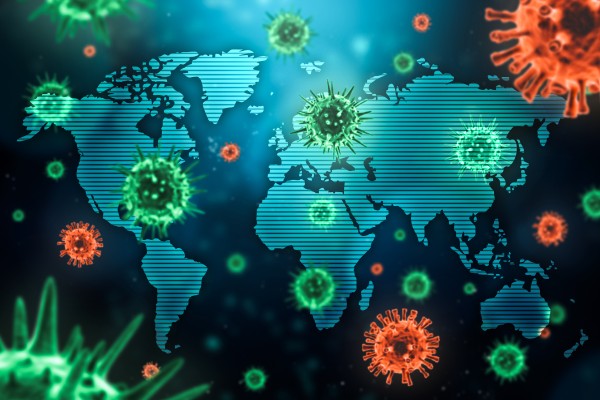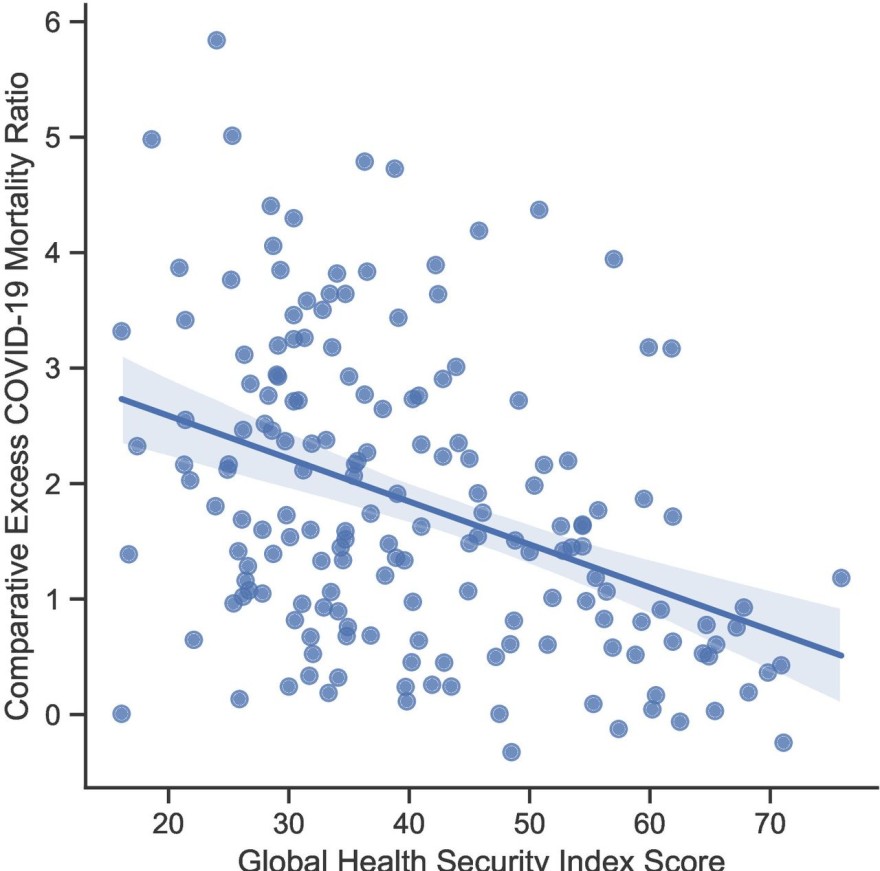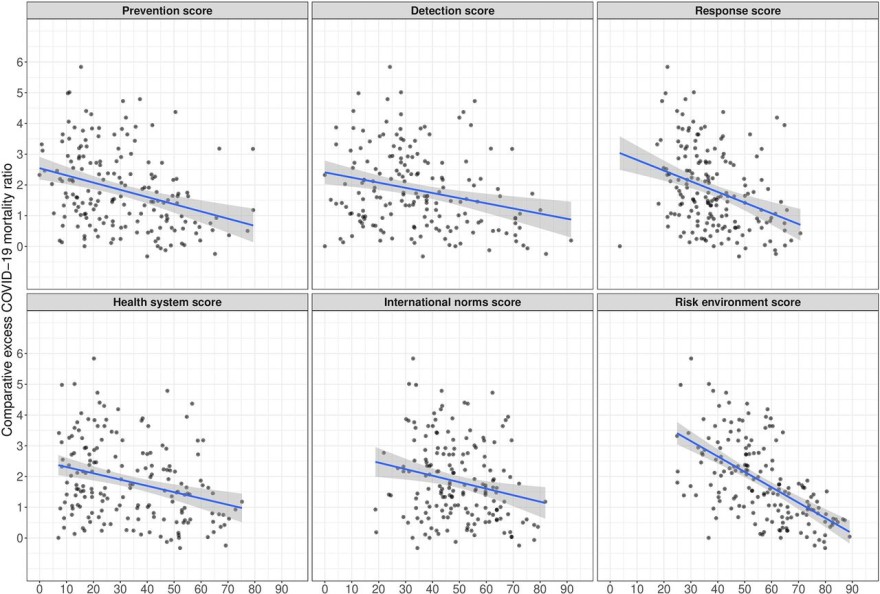Summary
This Briefing highlights how the world remains vulnerable to the persisting risk of pandemics. The Global Health Security (GHS) Index is one tool for finding out how prepared countries are for pandemics. It was created in 2019 to benchmark countries. However, analysis early in the Covid-19 pandemic did not show the expected correlation between GHS Index scores and Covid-19 outcomes.
Just published research now demonstrates that countries’ GHS Index scores do predict Covid-19 outcomes. Additionally, scores in the ‘Risk environment’ category are most predictive, yet this category is not included in other preparedness tools such as the WHO’s Joint External Evaluation.
Aotearoa New Zealand—which ranks 13th on the index—can continue to reduce its vulnerability to biothreats by using tools such as the GHS Index, as well as learning from international exemplars such as the UK’s just-released comprehensive Biological Security Strategy.
The world continues to face biological threats
Major health crises beyond the Covid-19 pandemic are almost certain in the future. The risks include pandemic influenza or a new infectious disease, as well as deliberate biological attacks or accidental release of agents used in biodefence research.
The world may have learned some lessons from Covid-19, but a recent international scenario exercise indicated there is still work to do. In the fictional scenario, a state-sponsored agricultural attack led to a human pandemic because ongoing cyberattacks undermined the accuracy of data about the outbreak. This interplay between advancing technology and biothreats is concerning. Participants in this exercise agreed that current systems for assessing biological events of unknown origin are not up to the task. Compounding this is the risk that the new WHO treaty on future pandemics is being watered down and the design of future bioweapons could be informed by artificial intelligence.
The Global Health Security (GHS) Index
The GHS Index is a comprehensive, criteria-based assessment of health security capabilities across 195 countries. It encompasses six categories relevant to health security and biological threats: Prevent, Detect, Respond, Health System, International Commitments, and Risk Environment.
However, during the early stages of the Covid-19 pandemic, research indicated that countries with the highest preparedness capacities paradoxically experienced the greatest levels of Covid-19 burden.1 For example, one study suggested that the higher the GHS Index score, the worse the impact of Covid-19.2
This finding was surprising given that analyses of pre-Covid-19 communicable disease data had found that the GHS Index was a valid predictor of mortality. For example, our own independent validation analysis of the GHS Index 2019, found that the proportion of deaths from communicable diseases decreased 4.8% for each 10-point rise in GHS Index.3
One possible reason for the perplexing GHS Index vs Covid-19 findings could be that more developed countries with high GHS Index values had provided better quality data, which biased analysis.4
New research on the GHS Index
A paper just published in the journal BMJ Global Health, presents an updated analysis of Covid-19 mortality for 183 countries, against GHS Index scores.5 Importantly, this analysis used data accounting for excess deaths (not just those formally attributed to Covid-19), throughout the pandemic (not just at the beginning) and accounted for the different age structures of countries’ populations. The analysis used data from the Institute for Health Metrics and Evaluation (IHME) modelling database and compared it to results derived from data that relied more heavily on country-reported deaths.
Results from this new analysis showed that country GHS Index scores were negatively associated with excess Covid-19 deaths (or more precisely age-specific cumulative mortality ratios) meaning that better preparedness predicted fewer deaths (see Figure 1, from Ledemsa et al5).
In particular, the ‘Response’ score and ‘Risk environment’ score appear to have the greatest correlation with reduced Covid-19 mortality (see Figure 2, from Ledemsa et al5).
This finding is counter to earlier claims that better GHS Index scores correlated with worse Covid-19 outcomes and provides some additional support for the use of the GHS Index as a metric of pandemic preparedness.
Of note were the strong results for the ‘Risk environment’ category, which assesses the socioeconomic, political, regulatory, and ecological factors that increase vulnerability to outbreaks. Notably this score includes government effectiveness and public confidence in government, as well as the level of inequality and social exclusion. Other, specific comments on the findings, are in the Appendix.
What this means for NZ?
We have previously described NZ’s rather suboptimal GHS Index score prior to the Covid-19 pandemic7 (with additional detail here:8). We also described how this score had improved in the 2021 version of the GHS Index, with NZ lifting its ranking to become 13th in the world at 62.5/100.9There is also the prospect that the Royal Commission of Inquiry into NZ’s Covid-19 response (currently underway), will make recommendations for even further improvements.
But in the meantime, NZ should continue to optimise government effectiveness, strive to achieve equitable approaches with strong Māori leadership, and address sociological factors important in pandemic outcomes. This new research emphasises the need for central planning, effective decision-making mechanisms, and continued focus on issues of social cohesion and trust. Trust and cohesion are already looming vulnerabilities for NZ and in a pandemic context they are life and death.
The NZ Government should also advocate for newly recommended international approaches such as a UN Joint Assessment Mechanism for outbreaks of unknown origin, as well as a Response Coordination Unit. It should also identify and develop solutions to the highest priority cyber-biosecurity vulnerabilities and invest in stronger biothreat intelligence capabilities.
The latter feature strongly in the UK’s new Biological Threat Strategy, which includes a responsible Minister, a 'Biothreats radar', a 100-days vaccine action plan, and a Biological Security Task Force (responsible for exercising capabilities).
Understanding the drivers of future biological harms can help us take effective actions to both prevent future pandemics and minimise harms if they cannot be avoided.
What is new in this Briefing?
- One tool for informing pandemic preparedness is the Global Health Security (GHS) Index. While some doubts initially arose that it did not predict Covid-19 pandemic outcomes, a just published analysis now demonstrates that countries’ GHS Index scores do predict Covid-19 outcomes.
- In particular, the GHS Index score in the ‘Risk environment’ category were most predictive, yet this category is not included in other preparedness tools such as the WHO’s Joint External Evaluation.
Implications for public health practice and policy
- The NZ Government can have some confidence in using the GHS Index to help guide its pandemic preparedness efforts.
- But NZ should also learn from international exemplars such as the UK’s just-released comprehensive Biological Security Strategy.
Authors
Dr Matt Boyd, Director, Adapt Research Ltd
Prof Nick Wilson, Department of Public Health, University of Otago, Wellington, and Co-director of the Public Health Communication Centre (PHCC)
Appendix – Additional notable features of the new analysis by Ledesma et al
In the new analysis by Ledesma et al, ‘Health system’ score was the only category that was not clearly correlated with reduced excess mortality. However, when the authors adjusted for countries’ income and Covid-19 mitigation strategies (using the Oxford Stringency Index) the expected relationship was found.
‘Commitments to international norms’ and the ‘Risk environment’ are factors not considered by many other measures of pandemic preparedness (such as the WHO’s Joint External Evaluation process), yet both correlated with excess Covid-19 deaths.
The results using the IHME database were not replicated using WHO and The Economist excess mortality models (except for the ‘Risk environment’ category). The authors hypothesise that this is because the WHO and Economist models have a higher correlation with reported Covid-19 mortality and are not fully accounting for excess deaths. Underreporting of Covid-19 deaths is a particular problem, with surveillance studies suggesting actual Covid-19 deaths are ten times greater in some regions.6
The analysis specifically identifies NZ doing well in the ‘Risk environment’ category:
“While countries such as Iceland, Australia and New Zealand had the top 4 lowest CMRs [comparative mortality ratios] and in the top 20 in risk environment. Evidence suggests that New Zealand was able to mount a success response because of strong leadership coordinating with many institutions to implement response measures in real-time, prioritisation of vulnerable populations in responses, effective communication strategies that induced population-wide support of responses and swift institutional approval of pandemic tools.”
Furthermore, NZ was one of the few countries in the analysis to have negative excess mortality in the 2020-2021 period, using the IHME data (See Figure S3, from Ledemsa et al5).



